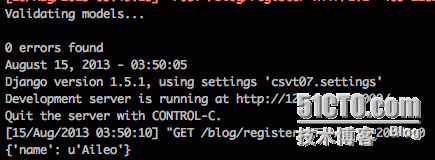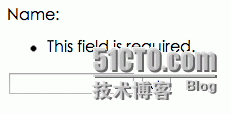Django 表單
#創建一個新項目以及一個APP
django-admin.py startproject csvt07
cd csvt07
django-admin.py startapp blog
#修改配置文件
vim blog/settings.py
#數據庫配置
MANAGERS = ADMINS
DATABASES = {
'default': {
'ENGINE': 'django.db.backends.sqlite3', # Add 'postgresql_psycopg2', 'mysql', 'sqlite3' or 'oracle'.
'NAME': 'mydb.db', # Or path to database file if using sqlite3.
# The following settings are not used with sqlite3:
'USER': '',
'PASSWORD': '',
'HOST': '', # Empty for localhost through domain sockets or '127.0.0.1' for localhost through TCP.
'PORT': '', # Set to empty string for default.
}
}
#增加blogAPP
INSTALLED_APPS = (
'django.contrib.auth',
'django.contrib.contenttypes',
'django.contrib.sessions',
'django.contrib.sites',
'django.contrib.messages',
'django.contrib.staticfiles',
'blog',
# Uncomment the next line to enable the admin:
# 'django.contrib.admin',
# Uncomment the next line to enable admin documentation:
# 'django.contrib.admindocs',
)#修改鏈接對應的處理視圖
vim blog/urls.py
from django.conf.urls import patterns, include, url
# Uncomment the next two lines to enable the admin:
# from django.contrib import admin
# admin.autodiscover()
urlpatterns = patterns('',
# Examples:
# url(r'^$', 'csvt07.views.home', name='home'),
# url(r'^csvt07/', include('csvt07.foo.urls')),
# Uncomment the admin/doc line below to enable admin documentation:
# url(r'^admin/doc/', include('django.contrib.admindocs.urls')),
# Uncomment the next line to enable the admin:
# url(r'^admin/', include(admin.site.urls)),
url(r'^blog/register$','blog.views.register'),
)#創建模板目錄和模板文件register.html
mkdir blog/templates && vim blog/templates/register.html
<?xml version="1.0" encoding="UTF-8"?> <!DOCTYPE html PUBLIC "-//W3C//DTD XHTML 1.0 Strict//EN" "http://www.w3.org/TR/xhtml1/OTD/xhtml1-strict.dtd"> <html xmlns="http://www.w3.org/1999/xhtml" xml:lang="en" lang="en"> <head> <meta http-equiv="Content-TYpe" content="text/html; charset=UTF-8" /> <title></title> </head> <body> <form method="post"> `form` <input type="submit" value="ok"/> </form> </body>
#創建對應的視圖處理
vim blog/views.py
# Create your views here.
from django import forms
from django.http import HttpResponse
from django.shortcuts import render_to_response
class UserForm(forms.Form):
name = forms.CharField()
def register(req):
if req.method == 'POST':
form = UserForm(req.POST)
if form.is_valid():
print form.cleaned_data
return HttpResponse('ok')
else:
form = UserForm()
return render_to_response('register.html',{'form':form})#啓動開發服務器
python manage.py runserver
#瀏覽器中訪問開發服務器
http://127.0.0.1:8000/blog/register
pic[form_1]
#點擊ok提交表單的時候會提示如下錯誤,CSRF***。
#官方的的說明
csrf_token
This tag is used for CSRF protection, as described in the documentation for Cross Site Request Forgeries.
pic[form_2]
#解決這個辦法就在settings.py中注視掉CSRF的類
vim blog/settings.py
MIDDLEWARE_CLASSES = (
'django.middleware.common.CommonMiddleware',
'django.contrib.sessions.middleware.SessionMiddleware',
# 'django.middleware.csrf.CsrfViewMiddleware',
'django.contrib.auth.middleware.AuthenticationMiddleware',
'django.contrib.messages.middleware.MessageMiddleware',
# Uncomment the next line for simple clickjacking protection:
# 'django.middleware.clickjacking.XFrameOptionsMiddleware',
)#再次點擊ok提交返回如下,證明成功提交表單數據。
pic[form_3]
#開發服務器會顯示一個字典的數據,因爲我們這沒有對數據做處理只是簡單的輸出
pic[form_4]
#如果提交的表單數據是空的話會提示如下信息
pic[form_5]





